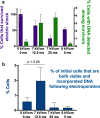Toward a genetic system in the marine cyanobacterium Prochlorococcus
- PMID: 33005871
- PMCID: PMC7523629
- DOI: 10.1099/acmi.0.000107
Toward a genetic system in the marine cyanobacterium Prochlorococcus
Abstract
As the smallest and most abundant primary producer in the oceans, the cyanobacterium Prochlorococcus is of interest to diverse branches of science. For the past 30 years, research on this minimal phototroph has led to a growing understanding of biological organization across multiple scales, from the genome to the global ocean ecosystem. Progress in understanding drivers of its diversity and ecology, as well as molecular mechanisms underpinning its streamlined simplicity, has been hampered by the inability to manipulate these cells genetically. Multiple attempts have been made to develop an efficient genetic transformation method for Prochlorococcus over the years; all have been unsuccessful to date, despite some success with their close relative, Synechococcus . To avoid the pursuit of unproductive paths, we report here what has not worked in our hands, as well as our progress developing a method to screen the most efficient electroporation parameters for optimal DNA delivery into Prochlorococcus cells. We also report a novel protocol for obtaining axenic colonies and a new method for differentiating live and dead cells. The electroporation method can be used to optimize DNA delivery into any bacterium, making it a useful tool for advancing transformation systems in other genetically recalcitrant microorganisms.
Keywords: Prochlorococcus; genetic system; intractable bacteria.
© 2020 The Authors.
Conflict of interest statement
The authors declare that there are no conflicts of interest.
Figures




Similar articles
-
Prochlorococcus: the structure and function of collective diversity.Nat Rev Microbiol. 2015 Jan;13(1):13-27. doi: 10.1038/nrmicro3378. Epub 2014 Dec 1. Nat Rev Microbiol. 2015. PMID: 25435307 Review.
-
Patterns and implications of gene gain and loss in the evolution of Prochlorococcus.PLoS Genet. 2007 Dec;3(12):e231. doi: 10.1371/journal.pgen.0030231. PLoS Genet. 2007. PMID: 18159947 Free PMC article.
-
Modeling selective pressures on phytoplankton in the global ocean.PLoS One. 2010 Mar 10;5(3):e9569. doi: 10.1371/journal.pone.0009569. PLoS One. 2010. PMID: 20224766 Free PMC article.
-
Genomes of diverse isolates of the marine cyanobacterium Prochlorococcus.Sci Data. 2014 Sep 30;1:140034. doi: 10.1038/sdata.2014.34. eCollection 2014. Sci Data. 2014. PMID: 25977791 Free PMC article.
-
Code and context: Prochlorococcus as a model for cross-scale biology.Trends Microbiol. 2007 Sep;15(9):398-407. doi: 10.1016/j.tim.2007.07.001. Epub 2007 Aug 10. Trends Microbiol. 2007. PMID: 17693088 Review.
Cited by
-
The Molecular Toolset and Techniques Required to Build Cyanobacterial Cell Factories.Adv Biochem Eng Biotechnol. 2023;183:65-103. doi: 10.1007/10_2022_210. Adv Biochem Eng Biotechnol. 2023. PMID: 36029350
-
Chitin degradation by Synechococcus WH7803.Sci Rep. 2023 Nov 15;13(1):19944. doi: 10.1038/s41598-023-47332-0. Sci Rep. 2023. PMID: 37968300 Free PMC article.
-
Dynamic Allocation of Carbon Storage and Nutrient-Dependent Exudation in a Revised Genome-Scale Model of Prochlorococcus.Front Genet. 2021 Feb 9;12:586293. doi: 10.3389/fgene.2021.586293. eCollection 2021. Front Genet. 2021. PMID: 33633777 Free PMC article.
-
Current Metabolic Engineering Strategies for Photosynthetic Bioproduction in Cyanobacteria.Microorganisms. 2023 Feb 11;11(2):455. doi: 10.3390/microorganisms11020455. Microorganisms. 2023. PMID: 36838420 Free PMC article. Review.
-
Species- and site-specific genome editing in complex bacterial communities.Nat Microbiol. 2022 Jan;7(1):34-47. doi: 10.1038/s41564-021-01014-7. Epub 2021 Dec 6. Nat Microbiol. 2022. PMID: 34873292 Free PMC article.
References
-
- Dick GJ, Lam P. Omic approaches to microbial geochemistry. Elements. 2015;11:403–408. doi: 10.2113/gselements.11.6.403. - DOI
LinkOut - more resources
Full Text Sources
Research Materials
Miscellaneous
